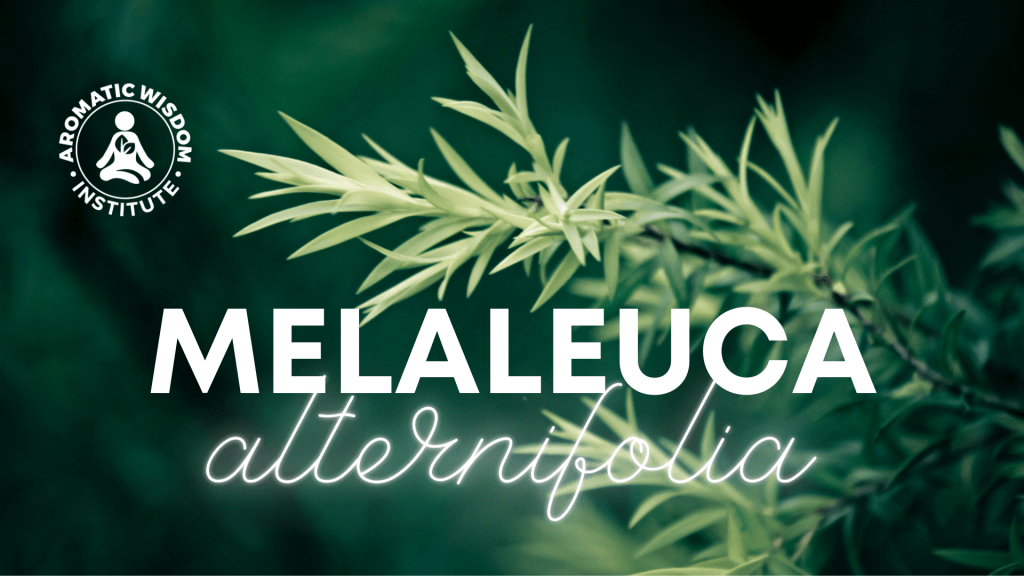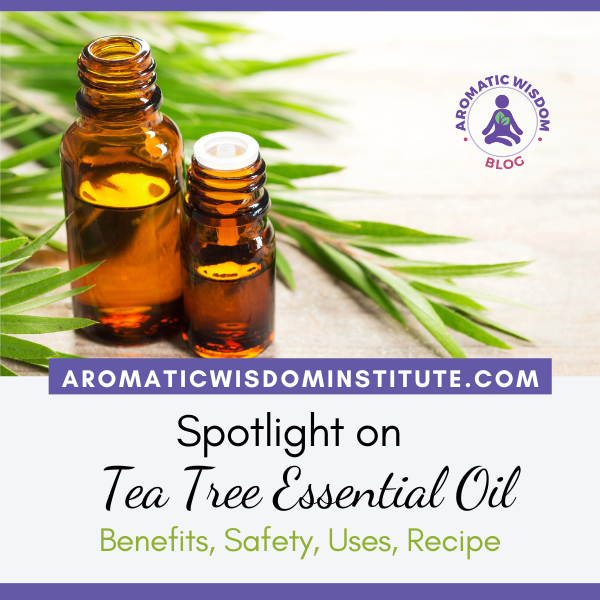Today’s featured essential oil should be
in everyone’s home pharmacy and first aid kit.
The remarkable antiseptic power of tea tree has been
one of the most researched, documented
and clinically proven of all the essential oils.
Essential Oil of Tea Tree
(Melaleuca alternifolia)

My personal relationship with Tea Tree
In my aromatherapy classes, I love asking students who smell Tea Tree for the first time to give me their impressions. It tends to surprise people. Because it is not an olfactory delight like Bergamot or Lavender, and the reactions I get are everything from paint thinner to pepper. Personally, I get an image of antique furniture when I smell Tea Tree.My personal tea tree stories and experiences could fill a book. Every time I watch the movie “Castaway”, I think how poor Tom Hanks could have really used a bottle for his bad tooth or coral-gouged leg. If I were only allowed to own one oil (perish the thought), Tea Tree would be the one.
The Foundations
- Why Every Aromatherapist Should Learn Essential Oil Chemistry, Episode 8
- Deep Dive into Essential Oil Chemistry Part 1, Episode 34
- Deep Dive into Essential Oil Chemistry Part 2, Episode 35
Therapeutic Properties of Tea Tree Essential Oil
(Here’s a glossaryto help you understand therapeutic property terminology.)
- Anti-inflammatory
- Anti-fungal
- Reduces nasal mucous production and swelling
- Removes excess mucus from the respiratory system
- Stimulates immune function
Applications: Tea Tree has the strongest impact on the skin and respiratory systems. It’s also great for mouth and gums.
(Here are some guidelines for making your essential oil blends in a safe dilution.)
- Sinus: Use in a steam inhalation for sinus decongestion or to help avoid a sinus infection
- Throat: Gargle: 8 oz warm water, 2 Tblsp salt, 5 drops Tea Tree
- Skin: put a dab on an infection or a pimple.
Learn: How to Do a Steam Inhalation with Essential Oils
Two Personal Tea Tree Essential Oil Success Stories
1. Many years ago, my brother Paul lived in Oregon and called me when he’d been hit by a car while riding his bike. He hadn’t broken any bones but did suffer a multitude of scrapes, gouges, and cuts that were rapidly becoming infected. He called in a panic asking what oil he should use to help the infection. I urged him to limp to the nearest health food store and buy tea tree oil, apply a drop or two over each of his open wounds 2-3 times a day. He called back two days later. “little sister…what the heck IS this stuff? Everything is healing so fast!?”
Blends well with: I never use Tea Tree in a blend for its aroma since it smells strongly medicinal, but rather for its specific therapeutic actions.
Tea Tree Essential Oil Recipes
1. Bathroom Group Scrub
3 tablespoons liquid castile soap
To Use: Add approximately 1 teaspoon of this mixture on a sponge to clean the shower, bathtub, bathroom sink; even the kitchen sink! The bathroom will smell clean and fresh and you won’t have inhaled any dangerous chemicals in the process!
2. Yoga Mat Spray
Ingredients:
10 drops Lavender (Lavandula angustifolia)
10 drops Tea Tree (Melaleuca alternifolia)
1 oz of Tea Tree Hydrosol in a spray bottle (you can also use water)
Directions: Add this blend together in a small spray bottle. Use the blend to clean your yoga mat before and after your session. It will also create a lovely aroma in the room before you begin.
My Tea Tree SoulCollage Card:

- I am a healing warrior
- I am a trusted companion on the path to health
- I uplift and energize
- I embody life-giving energy on all levels.
REFERENCES:
Julia Lawless, The Encyclopedia of Essential Oils (Updated Edition) (London: Harper Thorson, 2014), 189-190.
2. Keville, K. Aromatherapy, A Complete Guide to the Healing Art, The Crossing press, USA, 1995
3. Mojay G. Aromatherapy for Healing the Spirit, Henry Holt and Company Inc., England, 1996
4. Price S. Aromatherapy for Health Professionals, 2nd edition, Churchill Livingstone, 1999
5. Schnaubelt K. Advanced Aromatherapy, The Science of Essential Oil Therapy, Healing Arts Press, USA, 1998
6. Nye, S. (2006) Aromatic interventions for decubitus ulcer: a case report from South Africa. The International Journal of Clinical Aromatherapy 3 (2B): 25-28


Oh I love Tea Tree Oil, Liz!! It is one of my favorites, but I never thought to use it as a sinus steam. I’m going to need to try that one!! Thanks for the suggestion.
This time of year those steam inhalations are particularly important, Gretchen, to help combat sinus issue!
Hi Liz!
Great shares about tea tree!
But I thought it shouldn’t be used neat?..
Hmm, what are your thoughts?
Take care, Kathy
Hi Kathy, Tea Tree can be used neat in certain instances and only for a very short time to avoid sensitization.